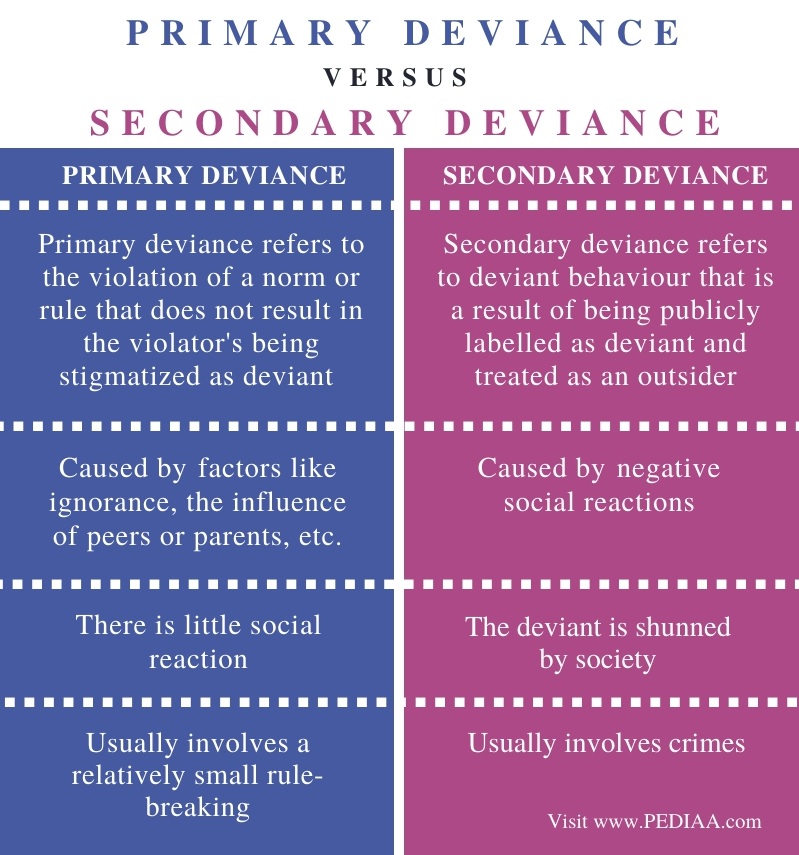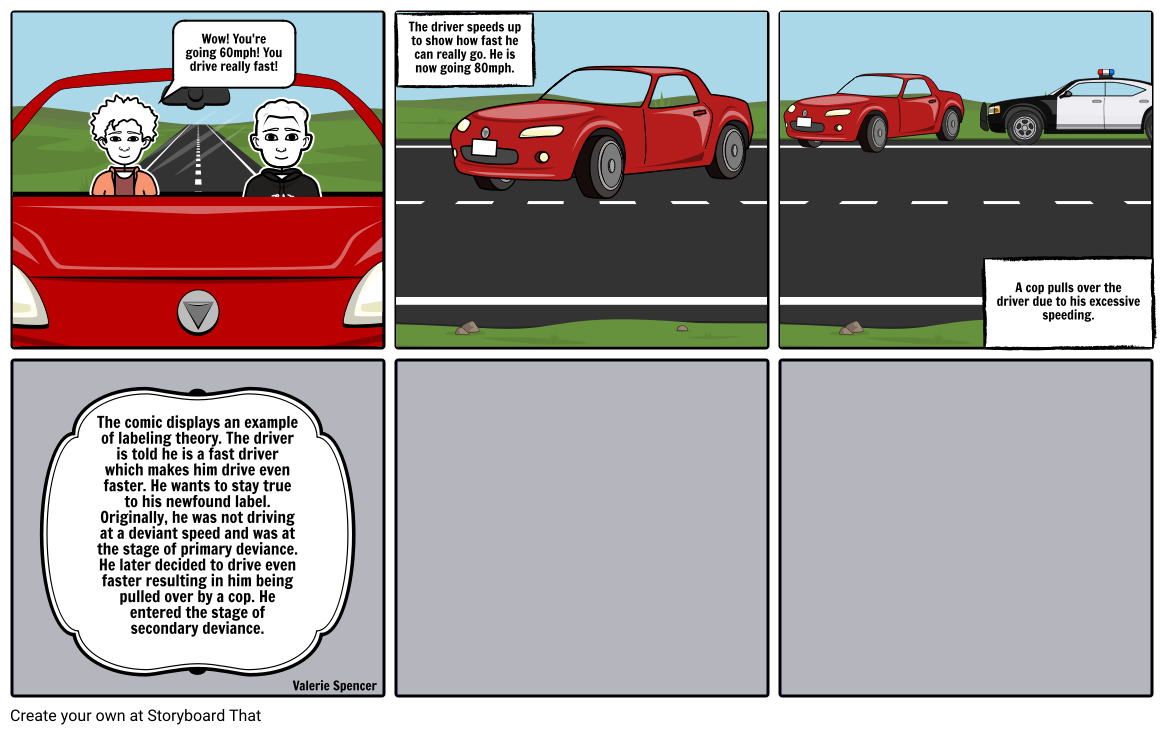Have you ever been labeled as “the troublemaker” or the “class clown”? Perhaps you’ve been told you’re “not cut out for success” or “too sensitive.” These labels, even if seemingly harmless, can have a profound impact on our lives, shaping how we see ourselves and how others perceive us. Understanding the difference between primary and secondary deviance helps us unravel the complex relationship between societal labels and individual behavior.

Image: pediaa.com
In this blog post, we’ll delve into the fascinating world of labeling theory, exploring how societies create and reinforce deviant behavior through their reactions to it. We’ll examine the crucial distinction between primary and secondary deviance, uncovering the mechanisms by which seemingly insignificant acts can escalate into a pattern of deviance.
Defining Deviance: What’s Normal and What’s Not
Deviance, in simple terms, is any act or behavior that goes against the prevailing norms, values, and expectations of a particular society or group. What is considered deviant can vary widely depending on cultural context, time period, and even the individual interpreting the behavior.
Imagine, for example, a group of college students throwing a party with loud music. In one neighborhood, this might be considered perfectly acceptable, while in another, it might be condemned as disruptive and inappropriate. The act itself (the party) remains the same, but its deviance is determined by the social context in which it occurs.
Understanding Primary Deviance: The Initial Act
Primary Deviance: The First Step
Primary deviance refers to the initial act of rule-breaking or non-conforming behavior. It’s the starting point, the first instance of deviation from societal norms. This initial act, often viewed as relatively minor, doesn’t necessarily define the individual as deviant in the eyes of society. Think of it as a single misstep, a fleeting moment of transgression.
For instance, a young teenager might skip school for a day, or a student might cheat on an exam. These acts, while technically violating rules, don’t inherently label the individuals as inherently deviant. They remain isolated incidents, often excused as youthful indiscretions.

Image: www.storyboardthat.com
Secondary Deviance: Labeling and its Consequences
The Power of Labels: Reinforcing Deviance
Secondary deviance, on the other hand, emerges as a result of societal reactions to primary deviance. It’s when an individual internalizes the label of deviant and begins to see themselves through the lens of this label. This is where the power of societal labeling becomes particularly significant.
Imagine a student who is labeled as “troublemaker” for skipping school. This label, reinforced by teachers, parents, and peers, can lead the student to internalize this perception and begin engaging in more disruptive behaviors. The label becomes a self-fulfilling prophecy, fueling a cycle of deviance amplified by social stigma.
The Spiral of Deviance
Secondary deviance often results in a “spiral of deviance.” Once labeled, individuals may find themselves ostracized, excluded, and denied opportunities for social integration. These negative consequences can further reinforce their deviant identity, leading to a cycle of deviant behavior.
The Importance of Social Support
It’s crucial to remember that not everyone labeled as deviant will succumb to the spiral of deviance. The presence of strong social support systems, positive role models, and opportunities for rehabilitation can counteract the negative effects of labeling and help individuals break free from the cycle of deviant behavior.
Current Trends in Labeling Theory
The study of labeling theory continues to evolve with new research exploring the complex interaction between social labels, identity, and behavior. Current trends focus on the role of social media in shaping and reinforcing labels – both positive and negative. The digital landscape, with its ability to amplify narratives and disseminate information swiftly, provides fertile ground for examining how online communities and social networks contribute to the creation and perpetuation of deviant labels.
Furthermore, contemporary research also examines the intersectionality of labeling, exploring the ways in which labels related to race, gender, class, and sexuality can compound the effects of deviance and lead to disparities in social outcomes.
Tips to Avoid the Spiral of Deviance
Understanding the dynamics of primary and secondary deviance can provide valuable insights:
- Mindful Social Interactions: Be cautious about labeling individuals, especially in a negative light. Remember that your actions and words have consequences. Engage in constructive dialogues rather than resorting to judgmental language.
- Empathy and Compassion: Cultivate empathy and understanding towards those who may be struggling with societal expectations or have engaged in deviant behavior. Acknowledge the role of social context and circumstances in shaping individual actions.
- Focus on Rehabilitation: Instead of simply punishing deviant behavior, prioritize interventions and support programs aimed at helping individuals break free from the cycle of deviance. Focus on promoting positive change and empowerment.
These tips provide a framework for fostering a more compassionate and understanding society, one that minimizes the negative impacts of labeling and promotes opportunities for rehabilitation and growth.
FAQ: Primary and Secondary Deviance
Q: What are some examples of primary deviance?
A: Examples include a student missing a class, a teen experimenting with drugs, or an individual engaging in acts of petty theft. These acts, while deviating from norms, don’t necessarily define the individual as deviant.
Q: How can secondary deviance become a self-fulfilling prophecy?
A: When an individual internalizes the label of deviant, they may begin to behave in ways consistent with the label, reinforcing the stereotype and leading to further deviant actions.
Q: What role does social media play in labeling?
A: Social media platforms can amplify labels and create echo chambers where negative stereotypes are reinforced. Conversely, online communities can also provide support and positive affirmation. Understanding the nuances of this online space is crucial for navigating the dynamics of labeling.
Primary Deviance Vs Secondary Deviance
Conclusion: From Labels to Understanding
Understanding the difference between primary and secondary deviance is crucial for promoting a society that fosters rehabilitation, compassion, and social justice. By recognizing the power of labels and their potential to shape both individual identity and social perceptions, we can move beyond simplistic judgments and towards a more nuanced understanding of the complex forces that shape human behavior.
Are you interested in learning more about labeling theory, its implications for social interactions, and the role of social support in overcoming negative labels? Please share your thoughts in the comments section below!





